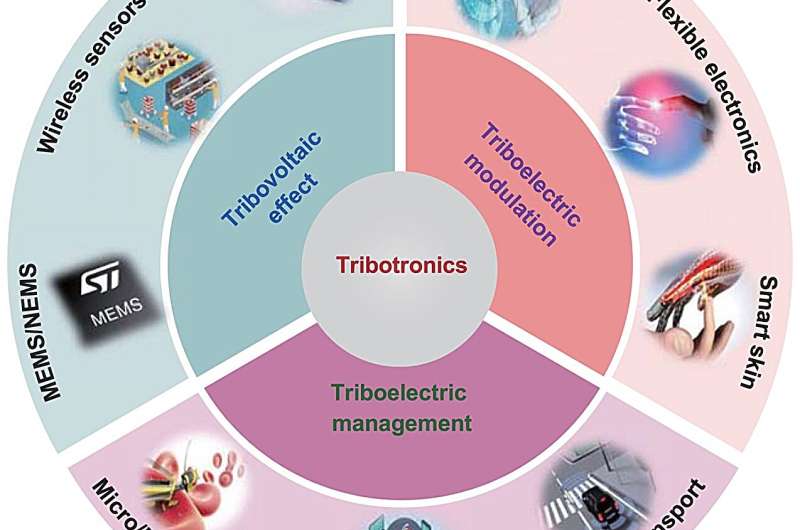This article has been reviewed according to Science X's editorial process and policies. Editors have highlighted the following attributes while ensuring the content's credibility:
fact-checked
proofread
Tribotronics: Promising prospects in the development of new functional devices and self-powered microsystems

Formed by the coupling effect of contact electrification and electrostatic induction, triboelectric nanogenerators (TENG) effectively convert the most widely distributed micro-nano energy in our environment, including human motion, breeze, vibration, and rainfall, into electrical energy, providing a sustainable solution to power a plethora of sensors that the current battery supply failed to address.
However, the output current and power of TENG are limited due to low surface charge density.
The acquired charges on the triboelectric surface remain limited and unstable, necessitating further strategies to enhance the output current and power density. Additionally, the triboelectric sensing has poor resolution, and stays in the macro-scale sensing regulation. Furthermore, TENG possesses an inherent capacitive internal impedance, requiring an effective power management strategy to reduce the output impedance of TENG and meet the demands of electronics and self-powered systems.
In response to the challenges faced by TENG, Prof. Chi Zhang's group from the Beijing Institute of Nanoenergy and Nanosystems carried out three branches of tribotronics that address these challenges by incorporating semiconductor materials and technologies, namely the tribovoltaic effect, the triboelectric field effect, and triboelectric energy management.
They realize the triboelectric device with high power density, triboelectric transistors with nanoscale gated effect, and triboelectric self-powered systems with high-efficiency energy supply, and the application demonstration of self-powered wireless sensor nodes has been carried out for industrial field.
Published in International Journal of Extreme Manufacturing, this research, by summarizing recent advances in tribotronics, aims to propel the development of new triboelectric appliances and self-powered microsystems in the fields of intelligent manufacturing, wireless sensor networks, and the industrial Internet of Things.
Professor Chi Zhang, the leading researcher, said, "With semiconductor materials instead of insulators as friction materials for TENG, direct current power generation has been observed, which is called the tribovoltaic effect. Compared with the TENG, the tribovoltaic generator is not limited by the surface charge density, which increases the current density by an order of magnitude, and has advantages in high power density."
The tribovoltaic effect occurs on the semiconductor interface. When friction is applied to the dielectric layer on the semiconductor surface, the triboelectric potential generated by friction can be used to regulate the carrier transport in the semiconductor. Co-author Dr. Junqing Zhao said, "The triboelectric potential generated by the TENG can be used as a gate voltage in a field-effect transistor, based on which active mechanical sensing and nanoscale tactile sensing can be realized."
In addition to studying the electronics of interfacial friction systems, the triboelectric power management method based on TENG is proposed using semiconductor technology to improve energy supply efficiency. Dr. Junqing Zhao believed, "The power management strategy of impedance reduction based on semiconductor device technology improves the power supply effect for sensors and microsystems, which breaks through the application of tribotronic devices in the field of self-powered sensing networks."
Professor Chi Zhang said, "Tribotronics is a new field exploring the interaction between triboelectricity and semiconductors. On one hand, research focuses on the electronics of interfacial friction systems, such as the tribovoltaic effect and the triboelectric field effect, to develop tribotronic devices for energy conversion, active sensing, and control."
"On the other hand, research focuses on triboelectric technology through electronics, encompassing energy modulation, storage, and utilization of triboelectricity, thereby enabling efficient collection of micromechanical energy and providing microenergy solutions for distributed sensing."
"However, some problems remain at this stage, including in-depth research of the energy conversion mechanism for tribovoltaic effect, the development of new tribotronic devices by combining innovative materials with manufacturing technology, and the improvement of triboelectric energy management to fully explore its potential new electromechanical applications. "
"By combining with a variety of disciplines such as nanoenergy and micro-electromechanical systems, tribotronics will expand the potential applications in new fields such as smart sensing, energy science, human-machine interface, and bioscience."
More information: Chi Zhang et al, Tribotronics: an emerging field by coupling triboelectricity and semiconductors, International Journal of Extreme Manufacturing (2023). DOI: 10.1088/2631-7990/ace669
Provided by International Journal of Extreme Manufacturing





















